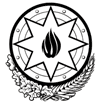Ilham Aliyev visits Nakhchivan new history and architecture museum complex


07 April 2014, 16:20
President Ilham Aliyev has visited the new Nakhchivangala history and architecture museum complex.
Azerbaijan pays great attention to preserving historical, cultural and religious monuments. Thanks to the numerous specific projects implemented by the state in this sphere, all such sites are now protected and under restoration. The creation of the Nakhchivangala history and architecture museum complex is further evidence that the state is taking large-scale measures in this field.
The territory of the Nakhchivan Autonomous Republic is one of the most ancient settlements of mankind in the world.
Cultural and architectural monuments relating to all periods of history are preserved here. The restoration and protection of such monuments is of great significance in terms of bringing the ancient history of Azerbaijan to future generations and also of boosting tourist interest in Nakhchivan. Nakhchivangala, which existed until the middle of the XVII century as a defensive fortress, was destroyed by wars and lost its former greatness. The restoration of Nakhchivangala began in 2010; restoration work was carried out on the historical territory and the fortress acquired its bygone appearance again.
The decision was taken last year to set up the Nakhchivangala history and architecture museum complex here in order to ensure the protection of Nakhchivan’s ancient and cultural heritage.
Extensive landscaping and improvements have been carried out around and inside the complex, a lighting system has been installed and strips of trees and shrubs have been planted.
During his visit to the museum complex, the head of state learned that in the uniquely-designed museum historical artifacts discovered on the territory of the Nakhchivan Autonomous Republic are presented in chronological order. The museum’s valuable exhibits include: a household pitcher dating from 5000 BC; various artifacts dating from 5000-3000 BC; ceramic artifacts dating from the Late Bronze Age and Early Iron Age; copper implements; grave monuments; weapons; parts of armored garments. Carpets and national dress dating from the XIX century are also on display here.
The historical and architectural monuments discovered in Nakhchivan are of great interest worldwide. They are evidence of the ancient roots of the history, culture, customs and traditions of the Azerbaijani people.
The creation of the museum complex proves that Nakhchivan, which is a cradle of human civilization, was a centre of trade, crafts, science and culture of the Orient for centuries; this territory is rich in material and cultural artifacts and historical monuments dating from the ancient, medieval, new and modern periods. There are around 600 historical and cultural monuments of global and countrywide significance on the territory of the Nakhchivan Autonomous Republic. An important factor boosting the historical significance of these places is that the grave of the prophet, Noah, lies not far from the fortress walls. In the first century AD, the Romano-Jewish historian Titus Flavius Josephus, and in the second century AD the Greco-Roman writer Claudius Ptolemy, mentioned Nakhchivan as the place where the Prophet Noah had lived, and in an article published in 1882, the Russian educationalist K.A. Nikitin writes that the city of Nakhchivan was founded by the Prophet Noah.
Throughout history, our people has created rich examples of culture and architecture on the territory of Azerbaijan’s Nakhchivan Autonomous Republic, one of the most ancient settlements of mankind in the world. Historical research shows that Nakhchivangala, which holds a special place among these architectural monuments, had not only a defensive purpose. The fortress at the same time was an inalienable part of the initial urban culture which arose here. In sources dating back to the early Middle Ages, historians refer to the city of Nakhchivan as a fortified fortress. A plan of the city of Nakhchivan of 1827 provides a schematic drawing of Nakhchivangala. The plan shows that the fortress had two sections – a small fortress, i.e., Naryngala, and a great fortress. Our people has been able to preserve the remains of Naryngala to this day. The fortress walls are built of a mixture of stone and clay and strengthened by semi-circular towers. Houses were mainly built along the fortress walls and their roofs were used to move the fortress troops and guards. Rich archeological materials were discovered during research carried out in Nakhchivangala in the middle of the last century – clay dishes and stone hammers used as work tools in salt mines. This increases even more Nakhchivangala’s significance as an historical and ethnographical territory where craftsmanship developed and urban culture was formed.
It was reported that restoration work has also been carried out on the cave situated on the complex. Inhabitants used the cave, which had several exits, including to Nakhchivan River, during military offensives and to break blockades. A feature of the fortress is that subterranean water pipelines ran under it which allowed the fortress denizens to maintain their water and food reserves in peacetime and during wars and blockades.
Having visited the museum complex, President Ilham Aliyev issued instructions and recommendations.
